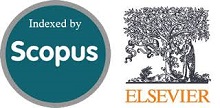Comparison of Structural Response Utilizing Probabilistic Seismic Hazard Analysis and Design Spectral Ground Motion
Abstract
Â
Doi: 10.28991/CEJ-SP2024-010-012
Full Text: PDF
Keywords
References
Saputro I.T. (2016). Evaluation of the response of multi-storey building structures using time history based on the PSHA method with shallow crustal earthquake sources. Master Thesis, Magister Teknik Sipil Univesitas Islam Indonesia Yogyakarta, Indonesia. (In Indonesian).
Pawirodikromo, W. (2019). On the capacity of high, moderate and low earthquake frequency content to cause global drift ratio at level-2 of structural performance. MATEC Web of Conferences, 258, 05027. doi:10.1051/matecconf/201925805027.
Utomo, J. (2019). Seismic performance evaluation of special moment frame using Perform 3D. Journal Media Komunikasi Teknik Sipil, 25(1), 27–37.
Widodo, P. (2023). Contibution of normalized Hysteritic Energy to damage Index in inelastic response of SDOF Structure due to earthquake. Journal Teknisia, 28(01), 055–069.
Bayati, Z., & Soltani, M. (2016). Ground motion selection and scaling for seismic design of RC frames against collapse. Earthquake and Structures, 11(3), 445–459. doi:10.12989/eas.2016.11.3.445.
Irsyam, M., & Hendriyawan, D. AD (2003) Seismic Hazard Assessment LNG Storage Tank Terminal Teluk Banten. Report of Seismic Hazard Study, Bandung, Indonesia.
Pawirodikromo, W., Makrup, L., Teguh, M., & Anggit, M. (2019). Bidirectional and Directivity Effect Identifications of Synthetic Ground Motions At Selected Site in Yogyakarta City , Indonesia. International Journal of Civil Engineering and Technology, 10(11), 149–166.
Artati, H. (2024). Liquefaction Potential Using a State Parameter Approach Based on Earthquake Peak Ground Acceleration Generated From Codes, Deterministic and Probabilistic Seismic Hazard Analysis. Dissertation Faculty of Civil Engineering, Islamic University of Indonesia, Yogyakarta, Indonesia.
Nugroho, N. S., Erizal1, Putra, H. (2021). Structure evaluation of building based on the earthquake response acceleration spectrum of the SNI 03-1726-2019. IOP Conference Series: Earth and Environmental Science, 871(1), 012013. doi:10.1088/1755-1315/871/1/012013.
Rocky, M. (2023). Earthquake Hazard Probability Analysis Of Indonesia’s New Capital City. Journal Media Komunikasi Teknik Sipil, 28(2), 284–291.
SNI 1726. (2019). Earthquake Resistance Planning Procedures for Building and Non-Building Structures Badan Standarisasi Nasional (BSN), Jakarta, Indonesia. (In Indonesian).
Kramer, S.L. (1996) Geotechnical Earthquake Engineering. Prentice-Hall, New Jersey, United States.
Gutenberg, B., & Richter, C. F. (1944). Frequency of earthquakes in California*. Bulletin of the Seismological Society of America, 34(4), 185–188. doi:10.1785/bssa0340040185.
Sadigh, K., Chang, C. Y., Egan, J. A., Makdisi, F., & Youngs, R. R. (1997). Attenuation relationships for shallow crustal earthquakes based on California strong motion data. Seismological Research Letters, 68(1), 180–189. doi:10.1785/gssrl.68.1.180.
Youngs, R. R., Chiou, S. J., Silva, W. J., & Humphrey, J. R. (1997). Strong ground motion attenuation relationships for subduction zone earthquakes. Seismological Research Letters, 68(1), 58–73. doi:10.1785/gssrl.68.1.58.
Boore, D. M., & Atkinson, G. M. (2008). Ground-motion prediction equations for the average horizontal component of PGA, PGV, and 5%-damped PSA at spectral periods between 0.01s and 10.0s. Earthquake Spectra, 24(1), 99–138. doi:10.1193/1.2830434.
ERPI. (1986). Seismic Hazard Methodology for the Central and Eastern United States. Electric Power Research Institute (ERPI), Palo Alto, United States.
Nikolaou, A. S. (1998). A GIS platform for earthquake risk analysis. State University of New York at Buffalo. Ph.D. Thesis, State University of New York at Buffalo, Buffalo, United States.
Cornell, C. A., & Vanmarcke, E. H. (1969). The major influences on seismic risk. Proceedings of the fourth world conference on earthquake engineering, 13-18 January, 1969, Santiago, Chile.
Youngs, R. R., & Coppersmith, K. J. (1986). Implications of fault slip rates and earthquake recurrence models to probabilistic seismic hazard estimates. International Journal of Rock Mechanics and Mining Sciences & Geomechanics Abstracts, 23(4), 125. doi:10.1016/0148-9062(86)90651-0.
McGuire, R. K. (1976). EQRISK: Evaluation of earthquake risk to site. Open File Report, 76, 67, A Computer Program Distributed by NISEE/Computer Applications, Geological Survey, United States Department of the Interior, Washington, United States.
Bardet, J. P., & Tobita, T. (2001). NERA: a computer program for nonlinear earthquake site response analyses of layered soil deposits. Department of Civil Engineering, University of Southern California, California, United States.
DOI: 10.28991/CEJ-SP2024-010-012
Refbacks
- There are currently no refbacks.
Copyright (c) 2024 Pranowo Pranowo

This work is licensed under a Creative Commons Attribution 4.0 International License.






